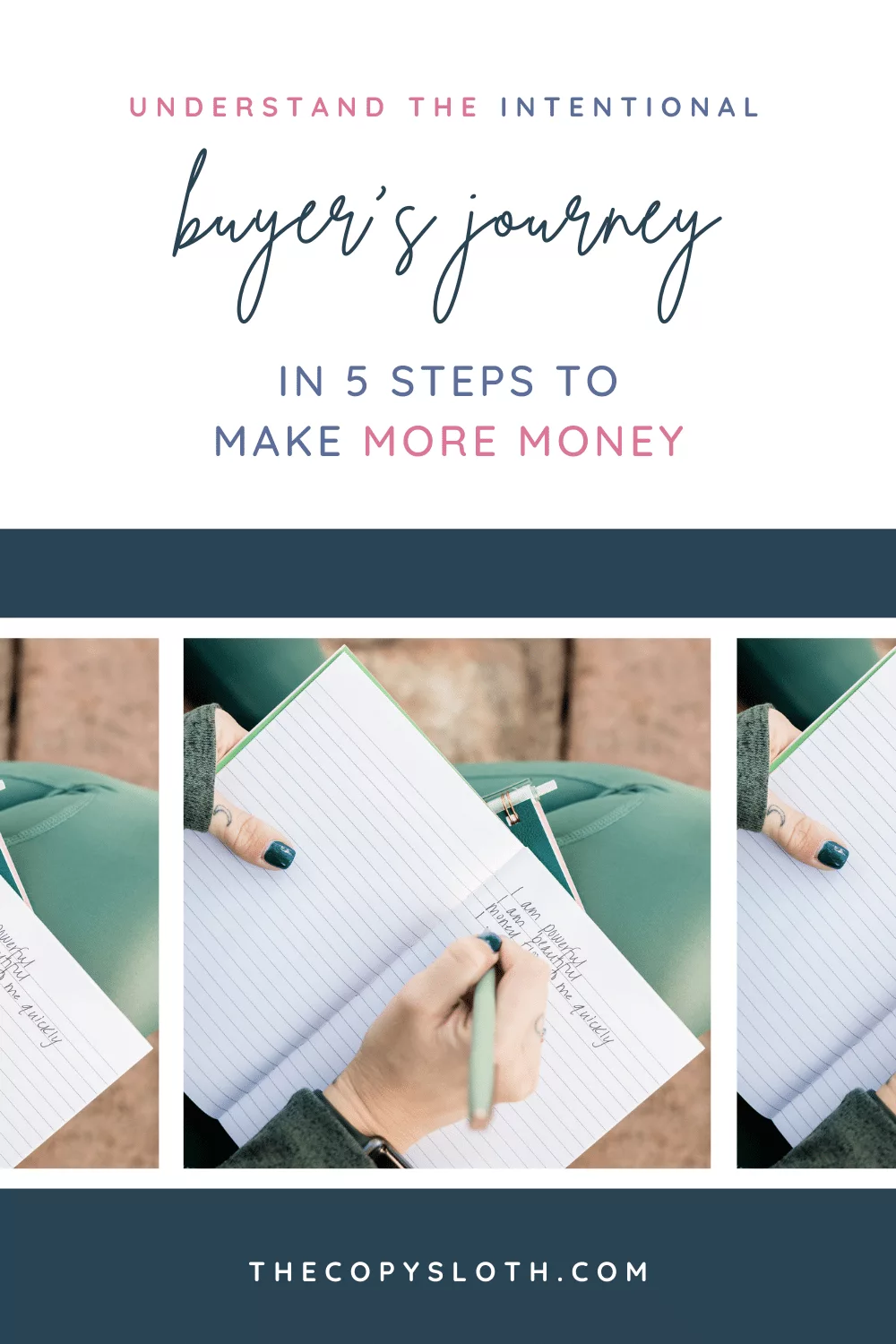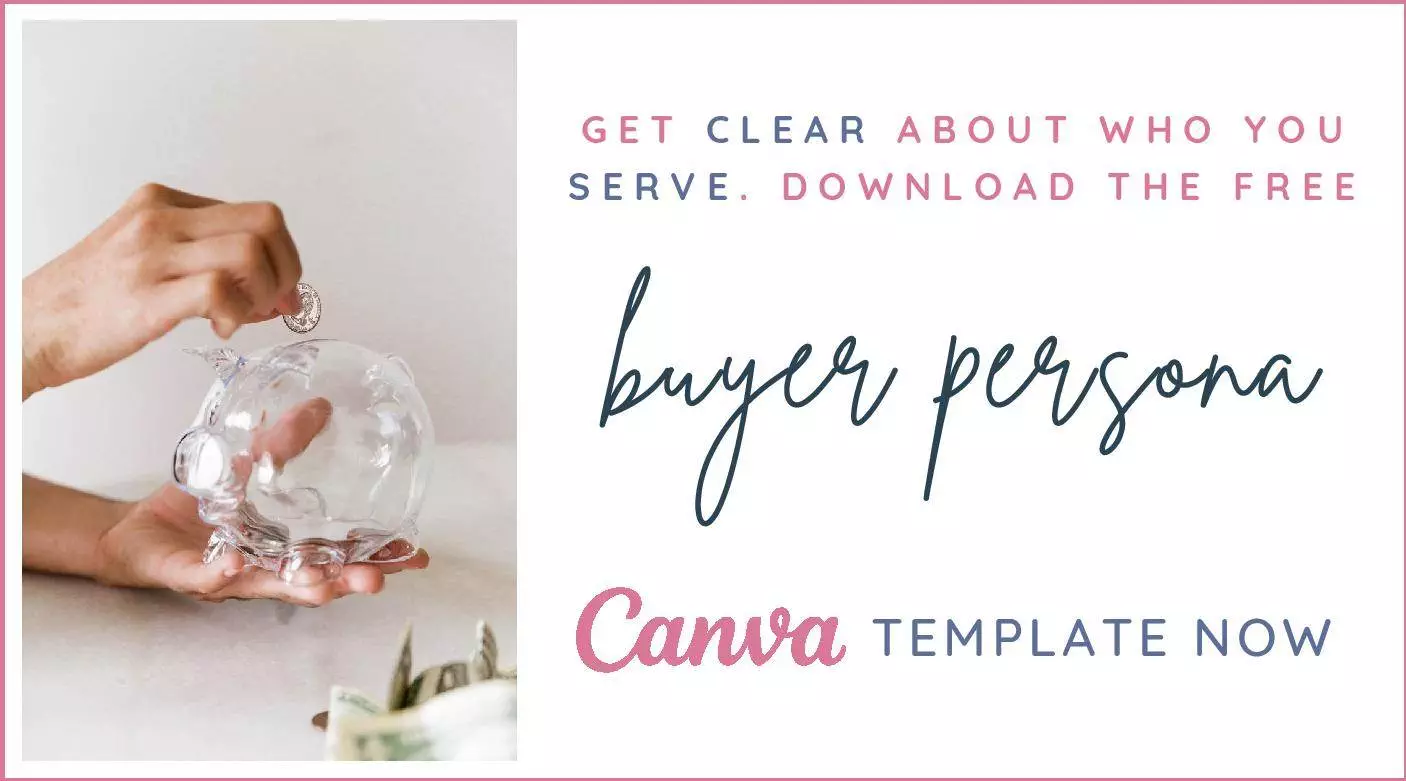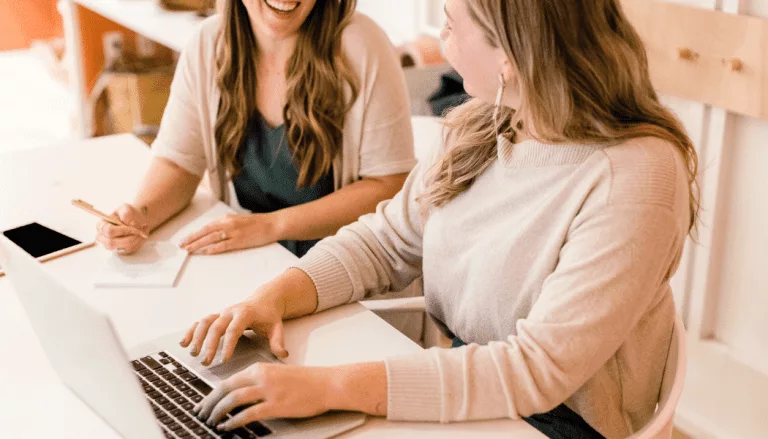This post may contain relevant affiliate links. These give me a small commission at no additional cost to you if you make purchases with them. Please see my disclaimers for more information.
The intentional buyer’s journey isn’t the straight line you might think it is. Just like life, this journey has a lot of detours, backtracks, fast-tracking, and distractions that give each buyer their own space on your offer ladder.

But I don’t believe that any buyers are the same. Enter the intentional buyer’s journey. This isn’t your average customer journey map post that will regurgitate the same info as all the rest. Today, I’m sharing my personal thoughts about how I feel the buyer’s journey should be.
Being a copywriter really changed the way I perceive this journey. The world of marketing, until recently, has banked on people’s insecurities and fears and doubled down on preying on the vulnerable.
As online business owners, it’s not our job to convince people to buy our stuff. Rather, it’s our duty to create offers that fit the needs of the people we want to serve or help.
That’s why I’ve reimagined what the buyer’s journey could be. Being intentional about your client journey map gives you more power than you might initially realize. By creating a sales funnel that supports every buyer, you can better authentically give your support while having profit inclusive to every budget.
This post is all about the intentional buyer’s journey, a framework that’s built on the foundation that every buyer matters.
The Intentional Buyer’s Journey
If you’re serious about turning a hobby or passion into a thriving business this year, you NEED to jump on the buyer’s journey train. In my experience, it’s the single difference between business owners who give up and the ones who rise above that start-up grind.
Table of Contents
STEP 1: Understanding the Buyer’s Journey
Despite what you think, your business isn’t about you. Every business has an ideal buyer or client they want to serve (you know, if they’re actually going to earn that little thing called moo-lah). This has been the most important advice that I’ve followed, personally.
When you’re opening up that fresh Google Doc to write down #AllTheThings about the services or product YOU’RE excited about, it’s so easy to lose sight of this one (tiny little) thing: Every offer you create is for someone else. (Side note: Raise your hand if you’re like me and you often just end up staring at that blinking cursor for what feels like hours on end.)
Knowing your buyer is Step 0 for (almost) every part of your business. If you’re all starry-eyed and want to nail down your buyer persona, I’ve created a Canva template for you!
What is the buyer’s journey?
The buyer’s journey is a staple in the world of marketing. It’s the core of every sales funnel and business. You’ll see a slight variation on the number of steps in this, but the essential soul and function of a buyer’s journey funnel is to map out your buyer’s choices as they decide whether they’ll purchase or skip your offers, services, or products.
The original buyer’s journey was first introduced in 1966. Eugene Schwarts published the infamous book, Breakthrough Advertising. Within it, he introduces the five general phases of buyer awareness.
But as I said, you’ll see different versions of it floating around. This blog post is no exception! The beautiful part about the buyer’s journey is that you can fit it to your business if something doesn’t resonate with your sales funnel.
Who is the buyer’s journey for?
The short answer? Every business owner (or anyone who sells something) should have their buyer’s journey mapped out. Now for the long one…
As I mentioned, your buyer’s persona is the core of your business. If you have no buyer, you sell no offer, product, or service. It’s just that simple.
Now let’s dive deeper! You might have already guessed by my name, but I call myself The Copy Sloth for good reason. In the wild, these beautiful animals are the masters of their own energy. They conserve it until they see the right use for it.
Call me “lazy,” but I think they’re onto something special! Whether you call yourself a freelancer, an independent contractor, a service provider, or a business owner, you’re a CEO. Everything you do and each decision needs to be made with intent.
You might grow a successful business, but without the right strategic goals that align with the life you want (not the one you have currently) you end up running on fumes. Fast! Enter one of my favorite words: Sustainable.
In my book, I only envy successful CEOs who’ve grown their business sustainably. And before your mind skews toward the global green movement, what I’m talking about here is smaller. Making $10k per month means nothing if you don’t honor your own energy.
The intentional buyer’s journey is for people who strive to attract quality buyers. Not the masses. They arm themselves with sustainable strategies that grow organically from the roots up to big rewards (and payouts). This growth isn’t always slow. Just sustainable!
Why business owners should understand the buyer’s journey
Honestly, the buyer’s journey should be every CEO’s best friend! The more familiar you are to your unique buyer persona, you’ll be able to construct (or deconstruct) your entire offer ladder around that person.
You can perfect your sales funnel by knowing:
- How your buyers prefer to make their purchases
- What steps they avoid or phases they depend on for guidance or clarity
- How you can cater your buyer journey around them
- How to keep this journey as easy and effective as possible for them
But most importantly, understanding YOUR buyer’s journey allows you to create offers, services, and/or products they’ll actually want to invest or opt-in to.
Another great benefit to fully realizing this process gives you a signal of how much energy, commitment, and time you give to buyers in each phase. In the next section, you’ll see my signature buyer’s journey. It might look a little different to the other graphics you’ll see on Google. Trust me, that’s intentional, too. 😉
STEP 2: Breaking Down the Buyer’s Journey
Now that we’re all on the same page, we can finally get to the juicy stuff!
The chart you see below is my interpretation of the original buyer’s journey (also known as a “customer journey”). You see the inverted pyramid? There’s a reason why it gets smaller the deeper into the funnel map the buyer gets.

The whole point of that buyer persona is to give you a clear idea on who you talk to and how to shape your entire offer around THEM. It might seem strange to hear this at first, but not every buyer who enters into this sales funnel is your ideal buyer. The people who deserve the bulk of your energy, time, and commitment are those who hang out in the lower three phases: increasing the further in they go.
“Don’t half-ass two things. Whole ass one thing.” – Ron Swanson

Am I telling you to half-ass your content and offers at the awareness and educate/inform levels? Nope. I’m simply saying that pouring your entire heart into an Instagram content plan might not have the best ROI. Keep the acronym “SIS” in mind for every decision you make for your business:
- Strategic – Is this helping me to actually improve my business or serve my buyers?
- Intentional – Is this on purpose?
- Sustainable – Does it honor my time, commitments, and energy?
Here’s an example: If I paid a coach $1k for a group program and she routinely canceled or rescheduled our calls that I’ve already committed to just to host regular Facebook or Instagram lives with her followers… Yeah, I’ve got a bad taste about that.
I want you (everyone) to let go of this notion that if you’re not showing up on social media multiple times a day that you’re not showing up for your buyers or business.
I’m categorized as a service provider, but this really doesn’t take away the fact that everything you’re about to learn comes from the fundamentals of that iconic marketing process. The following concepts also work for product businesses (both physical and digital)!
Problem overwhelm phases
In this section of the journey, the buyer has something keeping them from achieving their desired outcome or goal that you can help them overcome. However, high-ticket offers aren’t on their radar.
Buyers in these stages are typically looking for:
- A helpful blog post to answer their Google search
- An in-depth YouTube video showing them how to DIY a small part of their larger problem
- A Band-Aid (maybe they can’t afford to outsource to a professional)
- A template that will set them up for success
- A quick, short-term solution
I don’t think it’s fair to say that everyone in this phase of the buyer’s journey is a beginner. Depending on your niche, they may well be well-versed in your apps, tools, or products. But the thing that typically unifies these buyers is that last bullet. They’re after a simple, easy fix.
How to serve these buyers
So here’s a brief list on how you can serve these buyers:
- Create a lead magnet – Focus on a single piece of the full problem your “Interest” buyers have. This satisfies their most immediate need while giving them an opportunity to look forward into the future and peek at what else you’ve got going on for them (Dang, girl! You’re magical.)
- Write helpful blog posts – Become their go-to resource for this problem. They might not join your list at first, but with enough value packed into the posts, you’ll attract the buyers who might just be the perfect candidates for later stages in this funnel!
- Create content – There’s no way around it. Social media is simply the best way for small business owners to market their businesses online. But that doesn’t mean it’s totally The Copy Sloth approved! I’m actually writing up another post going into my personal social media griefs, so stay tuned! But with the RIGHT strategy and content, your business can almost sell itself.
- Sell a micro product – If you’re on Facebook, you see those ads always ending in sevens, right? Create a batch of helpful templates your buyers want, and sell it for under $40. You might not have as many followers or emails, but you’ll at least have another stream of income coming in. You’ll also save some room on those expensive email marketing services, too!
Awareness
This stage is where your buyers’ Spidey-senses start to go off about that old problem you happen to solve. Once it’s on their radar, it’s hard to ignore. Admittedly, when I’m caught in this stage’s web, I tend to spend hours upon hours of research trying to find the solution to a five-second problem. Isn’t that always how it goes when you learn something new or something goes wrong?
These buyers are hungry for (almost) every resource they can get their hands on. They don’t know how to solve the problem, so why limit their options down to a few? What if the resources I have don’t actually work? Those are just a peek inside your Awareness buyer’s busy mind.
Educate/inform
Now that the initial panic/crisis has been avoided, your buyers start running into one more tiny problem/setback after another. It’s like a rabbit hole, but they just can’t seem to hit the “abort mission” button yet.
Cue you stage left! This is typically when they’re already on your email list, but you could also educate and inform your buyers via social media, YouTube videos, podcasts, and blog posts, too. There’s no one-size-fits-all in any of this. It’s in this stage where nurturing becomes the key to conversion.
Buyer intent phases
Buyer intent is kind of important to this whole process, huh? In these two stages, your buyers know who you are, and they sort of already have an idea if they’ll buy from you or not. Sometimes, they need more time to feel comfortable investing. However, it’s up to you to show them what results they’ll get when they work with you.
Buyers in these stages need or want:
- Clarity on a complex concept or task
- Strategy for a specific area, tool, or path toward more $$$
- A “next-steps” roadmap tailored to their business
- Pre-coaching or a mid-level, self-paced course
One of the most important things to keep in mind in this stage is that you buyers can absolutely slip back into the Problem Overwhelm Phase of this funnel. Life happens. Responsibilities collide with their other commitments. We’re human.
It’s important to let them go and let flow. Every stage of this process isn’t static. It’s very much a fluid journey! If they don’t unsubscribe (but stop engaging with your content/emails), send them a quick re-engagement email reminding them of who you are and what result they were after.
I personally don’t pitch to them in this sequence/email. Just welcome them back into your universe. Bonus points if you send them an exclusive freebie!
How to serve these buyers
So here’s a brief list on how you can serve these buyers:
- Intensives – Offer these buyers a 1:1, 60-minute clarity call targeting a very specific area of confusion. Intensives are the perfect bridge between the more shallow results found up at the top of your funnel and your full-scale service, offer, or product.
- Online courses – Self-paced or cohort group courses give your buyer the best of both worlds: your expertise and the freedom to learn at their own pace. Not every course needs to be priced high. I see several ones for around $297 that target a larger scope of the ultimate roadblock/problem your buyers struggle with.
- Day rates – Out of all of these suggestions, this is one I’m excited about trying out for myself this year. Day rates are becoming more and more popular within the service provider circles. Essentially, you charge your client one bulk price upfront, and they reserve you for an entire day to solve whatever it is they need. This doesn’t need to be exhaustive or intensive. It just needs to be a smaller version of your full-scale retainer services.
- Account upgrade – If you’re running a product, app, or tool business, make every effort to let your buyers know about the amazing features of your next available plan!
Interest
This isn’t your average buyer’s journey blog post! During this stage, your job is to introduce, nurture, and guide them to and through their own intention(s). They already know their larger problem. They know you can help them. But now it’s time to give them a space to feel accountable, supported, and even more informed than they were in the last stage.
At this point, we’re done solving just a problem! You need to hone in their interest on the results you provide. They may not be able to afford or want to join your high-ticket programs, but they’re tuned into all the mid-level offers, programs, and products available.
A catch 22 feeling can begin in this stage. They’re excited about what you sell, but there may still be some disconnect holding them back. 80% of the time, it’ll likely be your price. But it might be due to the fact that you haven’t nurtured enough trust between you and them yet.
This is the perfect opportunity for you to send out a coupon code, a strong testimonial, or an impressive case study. Maybe all they’re waiting on is a sign to buy-in!
Intention
Now that you’ve ensnared their interest, it’s decision time. The intention stage is ultimately the make or break moment. It’s important to offer your buyers what they need as opposed to what YOU want them to need.
Not everyone has a few thousand dollars lying around. A secondary stream of income for your business can be selling smaller digital products that each solves one piece of the larger problem(s) your high-ticket offers support or fix.
In this stage, you can really gauge your audience. If a few subscribers join a waitlist but don’t buy in on this launch, always remember to tag them to retarget for your next one! I think one thing most online business owners miss most is upkeep these people: anyone who’s opening your launch sequence emails or commenting on all of your social media posts.
Don’t forget about them, because they’ll forget about you!
Loyalty phase
Once you inspire your buyer to invest, book, or upgrade to this stage, you’ve honestly created a relationship with them. Of course, THESE are the people who’ve stuck with you through this entire journey. They’re excited about what you do and what you offer. Hell, they’re plain ecstatic to work with you. Congrats!
These buyers will be the first to join your high-ticket waitlists, upgrade their accounts on day one of a new feature rollout, or book your signature coaching programs. What’s special about this phase is the fact that you serve them an experience. Not just a result!
Buyers in this stage typically demand:
- Hand-holding while they learn your exact processes, systems, and strategies
- Access to the best features or user experience
- Plans tailor-made for their business by your hands
- The community you’ve cultivated around your brand/business
- Your time, energy, and commitment
How to serve these buyers
Nothing is more precious or valuable than your time. When you show up for buyers in this stage, you are able to show them your commitment. So here’s a brief list on how you can serve these buyers:
- Offer a complimentary consult – Call it a coffee chat, a strategy call, or consultation, giving your time to someone in the stage can be the personal touch they need to book your service or buy your high-ticket offers. This isn’t a discovery call, per se. It goes deeper with the intention of enhancing or celebrating the mutual relationship you’ve built with someone else. You can simply answer their questions or offer soft strategy support that helps Segway into your program or offer.
- Trial memberships – Give them a trial period of your product, offer, or service! This will give them the ability to poke around to see what all the fuss is about in their own time. This trait period doesn’t have to be offered for free, either! Simply discount your product’s actual cost for them for a certain number of days.
- Send a coupon – There’s a science behind offering coupons to people. If you have a portion of your email list of dedicated subscribers in this loyalty stage, send them an exclusive coupon code that you offer no one else!
Relationship
Ultimately, this is the stage every online business owner dreams of. You are the buyer’s go-to resource on this problem. Anytime they have a question, they’ll click that “buy now” button or be the first on your waitlists.
They know your services, products, and programs well. You’re basically their hero of the specific problem you’ve continued to support them through. That doesn’t mean they’ll always buy ALL of your offers, but you will mostly know these buyers personally. By name, even!
But this isn’t just a one-way arrangement. This stage is called “relationship” for a reason. These buyers are the people you go to when you have any questions, need case studies, or want to spoil with all those bonuses you have in your back pocket.
STEP 3: Be a More Intentional Business Owner
In my business, the letters “ROI” is synonymous with intention. Return on investment has become the focal point of my entire mindset heading into this new year. The biggest (and hardest pill to swallow for me was the fact that I was trying to make “Fetch” happen—particularly with social media.
I adore Instagram, but it’s just not that profitable for me to be all-in with. At the end of 2021, I (in the deepest trenches of depression) listed out all of the clients I’d had from the last two years in a Google Sheet. In a different column, I wrote out where that client had come from. The results? Facebook groups!
In the time I mindlessly scrolled through my beautiful feed, stressed out over my next reel, or felt guilty for not posting as much as I wanted to, I’d booked a total of six discovery calls—all in the first 10 days of 2022!
The only thing I changed? I strategically checked in on my business and reevaluated my client attraction strategy. I knew my content strategy had to change. So I gave up my beloved ‘gram in exchange for blogging. I plan on unpacking more about this in a future post!
Here are some things I want you to consider before you continue spreading yourself too thin:
- Where are you getting the most leads from?
- Is where you’re spending the most time giving you a strong ROI?
- What is the most important ROI for you to achieve your business goals?
STEP 4: How To Create Your Own Buyer’s Journey
Now that you’ve stepped into a more intentional mindset, you can begin to plan out your buyer funnel. Free resources you give out without first collecting an email in exchange and valuable Instagram captions are great.
But the difference between THIS buyer’s journey and others is the distinction that the funnel only begins once:
- a follower buys/opts-in to your smaller (or free) offers
- a prospect books a discovery call
- a blog reader gives their email for a resource
Where Social Media Fits into the Buyer Journey
Social media follows, likes, and comments just aren’t a sustainable way to convert into any kind of actual (or future) trackable currency. That might just be a hot take to a few of you, but hear me out.
Your content is simply a pre-step to this intentional buyer’s journey funnel map. That means it’s still an important piece, but I don’t consider it the first stage in this journey. These are all how you attract eyes to your business and build genuine connections with people. To me, creating content, content strategy, and social media marketing is simply a window or a welcome mat.
Until someone knocks (opt-in to your list or buys a small digital product), you don’t really know if anyone’s at the door. And you can’t live your life waiting on standby in the entry room. You have friends, family, and yourself all hanging out throughout the home.
When you take the pitch out of your day-to-day content strategy, you’ll be able to show up as a human being with your own quirks, personality, and charm. THAT’S what attracts clients! I don’t personally know one person in my social circles who loves hanging out with a car salesman on and off the car lot.
Getting Started
In order to get started, you need to have answers for each of the following general questions:
- Who is my buyer? Do I have more than one buyer?
- Are my buyers aware of their problem?
- How does each offer in my offer ladder/funnel solve a piece of or the whole problem?
- How and where will my future buyers find me?
- Where do my existing buyers come from?
- What platform sends me the most converting traffic?
- What phrases or keywords does my buyer search on Google for?
STEP 5: Other Ways To Use the Buyer’s Journey
Swipe these action step ideas:
- Tally up every client or buyer you served (if such data is trackable for you) and see which platform or source sent the most converting buyers to your offers.
- Service providers! Add this one question to your lead capture forms now: “How did you find me?”
- Reevaluate your marketing plan and content strategy. Where can you scale back and where can you improve for the best results?
- Map out your offer ladder/sales funnel! Create a cool visual graphic in Canva mapping out who each piece/stage is for (an what products are meant for which stage)
- Post polls on your Instagram stories for a bit of fun market research. In times of confusion, asking your audience for some clarity can be super helpful!
This post is all about the intentional buyer’s journey.
Ready to get your copy + content to that *chef’s kiss* status — fast & easy?
Inspire your buyers with copywriting & content strategy services for intentional brands & wanna-be energetic masters.
I pack my posts and content with value and strategies I’ve used in my own business. But nothing quite beats working 1:1 with the copywriter to create custom copy that goes beyond a single conversion.







